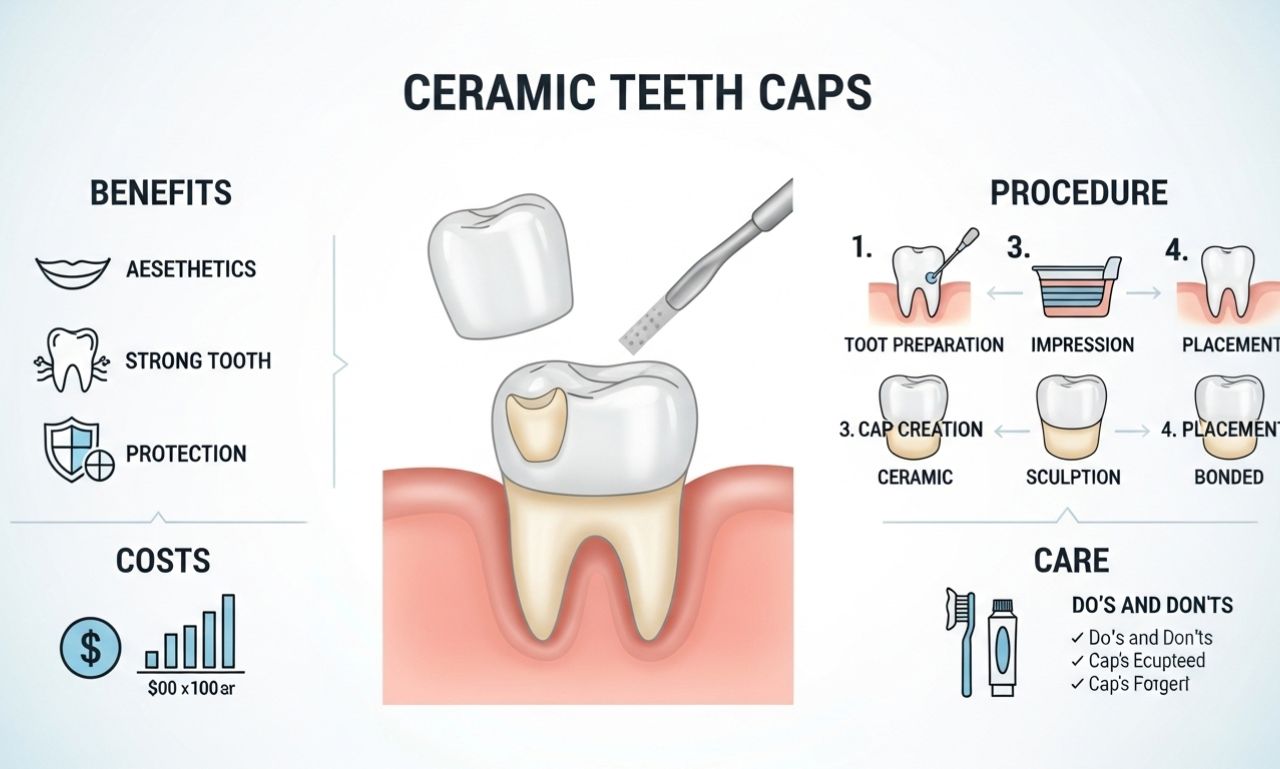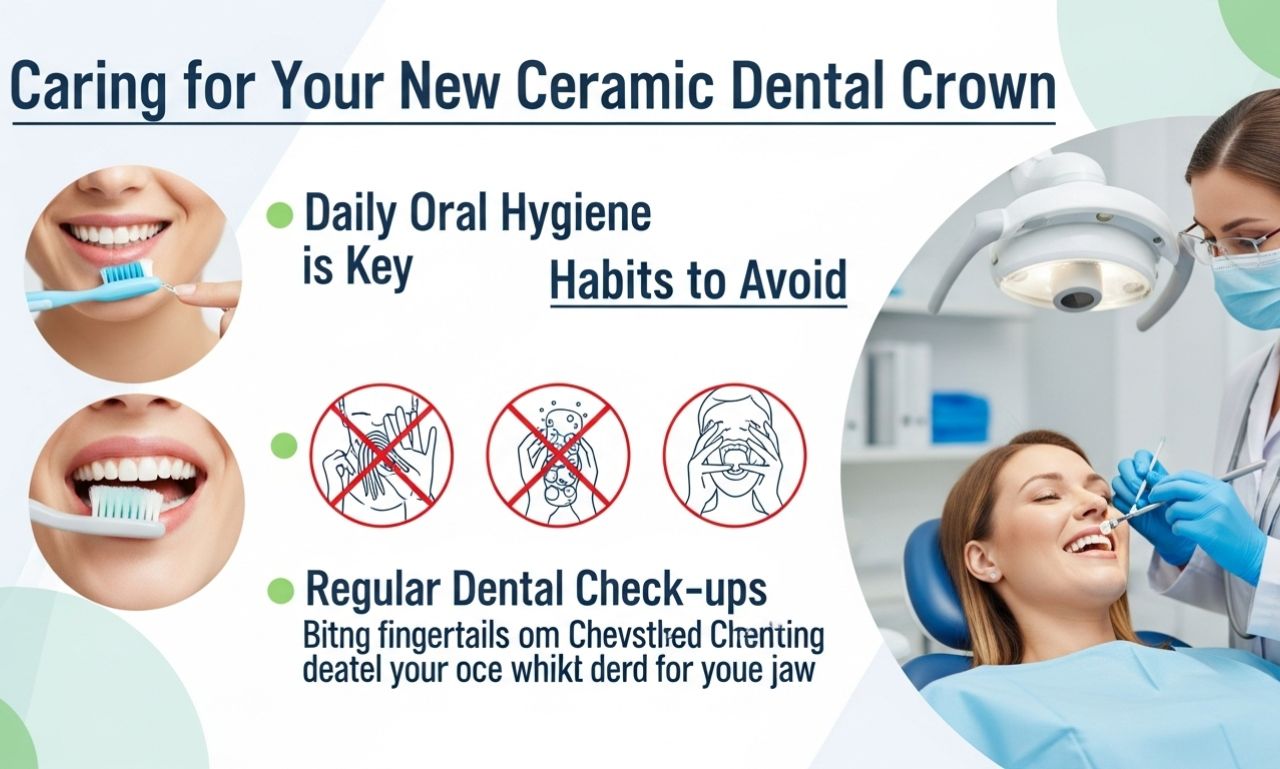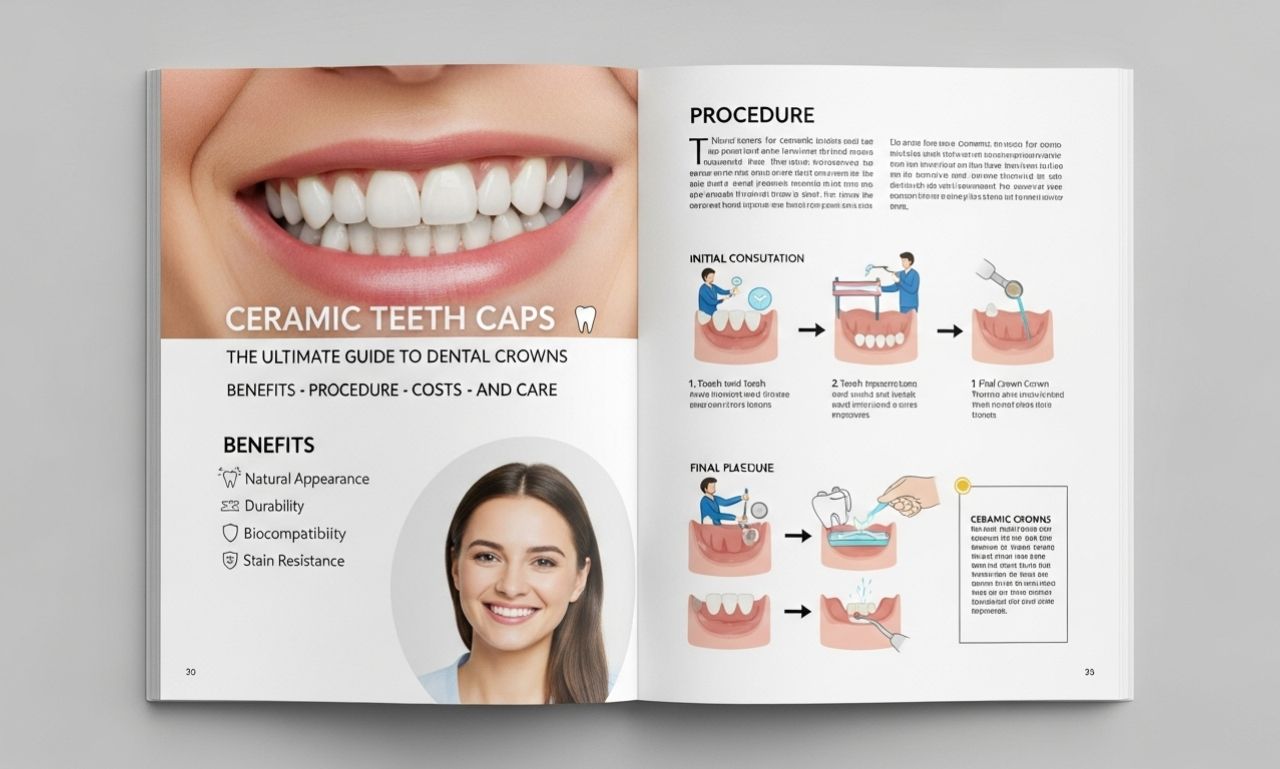A bright, confident smile can change how you feel and how others see you. But issues like cracks, severe decay, or discoloration can make you want to hide your teeth. Fortunately, modern cosmetic dentistry offers excellent solutions. One of the most popular and effective options for tooth restoration is the ceramic teeth cap, also known as a dental crown.
This guide will walk you through everything you need to know about ceramic teeth cap. We will explore what they are, the significant benefits they offer, what to expect during the procedure, and how to care for them. By the end, you’ll have a clear understanding of how this remarkable dental solution can restore both the function and beauty of your smile.
What Are Ceramic Teeth Cap?
A ceramic teeth cap, or all-ceramic dental crown, is a custom-made prosthetic that fits over an entire tooth. Think of it as a protective, tooth-shaped “hat” that covers the visible portion of a tooth down to the gum line. Its primary purpose is to restore the tooth’s original size, shape, strength, and appearance.
Unlike other types of crowns that may use metal, ceramic crowns are crafted entirely from high-grade, tooth-colored porcelain or other ceramic materials. This composition is key to their appeal, as it allows them to mimic the natural translucency and color of real teeth with incredible accuracy. This makes them a top choice for cosmetic dentistry, especially for visible front teeth.
These caps are not just for looks. They are a crucial tool in restorative dentistry, used to protect a weak tooth from breaking, hold a cracked tooth together, cover a tooth with a large filling, or restore a tooth that has been worn down. They are also used to cover dental implants or to hold a dental bridge in place.
The Unmatched Benefits of Choosing ceramic teeth cap Crowns
When considering tooth restoration, you have several options for materials, including metal, porcelain-fused-to-metal (PFM), and all-ceramic. While each has its place, ceramic teeth cap offer a unique set of advantages that make them a preferred choice for many patients and dentists.
Superior Aesthetics and Natural Look
The most significant benefit of ceramic teeth cap is their appearance. Because they are made from translucent porcelain, they reflect light in much the same way as natural tooth enamel. This allows them to blend seamlessly with your surrounding teeth. It’s often impossible for an observer to tell the difference between a ceramic crown and a natural tooth.

PFM crowns, while strong, have a metal base that can sometimes create a dark line at the gum line. This becomes more noticeable if your gums recede. All-ceramic crowns eliminate this problem entirely, ensuring a consistently natural and beautiful look for years.
Biocompatibility and Patient Safety
Biocompatibility refers to how well a material coexists with living tissue. Ceramic is highly biocompatible, meaning it is very unlikely to cause allergic reactions or gum irritation. For patients with metal sensitivities or allergies, all-ceramic crowns are the safest and most comfortable option. The smooth surface of the porcelain is also gentle on the surrounding gum tissue, promoting better oral health.
Strength and Durability for Long-Term Use
Early versions of ceramic crowns were sometimes considered less durable than their metal-based counterparts. However, advancements in dental technology have changed that. Modern ceramic materials, such as zirconia and lithium disilicate, are exceptionally strong and resistant to wear.
These advanced ceramics can withstand the significant biting and chewing forces exerted on molar teeth, making them a viable and durable option for any tooth in the mouth. With proper care, a well-made ceramic dental crown can last for 15 years or more, providing a long-lasting tooth restoration solution.
Precision Fit and Comfort
Ceramic teeth cap are designed using state-of-the-art digital imaging and CAD/CAM (Computer-Aided Design/Computer-Aided Manufacturing) technology. This allows for an incredibly precise fit. A perfectly fitted crown feels more comfortable, functions like a natural tooth, and prevents bacteria from seeping underneath, which could cause decay.
The Procedure: What to Expect When Getting a Ceramic Teeth Cap Crown
The process of getting a ceramic dental crown typically involves two appointments, though some clinics offer same-day crowns using in-office milling technology. Here is a breakdown of the standard, two-visit procedure.
Your First Visit: Preparation and Impressions
- Consultation and Examination: The journey begins with a thorough examination. Your dentist will assess the health of the tooth and surrounding bone, often using X-rays. They will discuss your options and confirm that a ceramic crown is the best solution for your needs.
- Tooth Preparation: To make room for the crown, your dentist will need to reshape the natural tooth. This involves removing a small layer of the outer enamel from the top and sides. The amount removed corresponds to the thickness of the crown. If the tooth has extensive decay, it may first need to be built up with filling material to create a solid foundation.
- Taking Impressions: Once the tooth is prepared, your dentist will take an impression of it, as well as the opposing teeth. These impressions can be made with a putty-like material or with a digital scanner. This impression serves as the mold from which your permanent crown will be crafted in a dental laboratory. The color of your natural teeth will also be matched precisely.
- Placing a Temporary Crown: A custom-made ceramic crown takes time to create. To protect your prepared tooth in the meantime, your dentist will fit you with a temporary crown. This temporary cap is usually made of acrylic and is secured with temporary cement. It allows you to eat and speak normally while you wait for your permanent restoration.
Your Second Visit: Placing the Permanent Crown
After about two to three weeks, your permanent ceramic crown will be ready. You will return to your dentist’s office for the final placement.
- Removing the Temporary Crown: Your dentist will carefully remove the temporary crown and clean the underlying tooth.
- Checking the Fit and Appearance: Before permanently bonding the new crown, your dentist will place it on your tooth to check the fit, color, and bite. They will make any necessary minor adjustments to ensure it aligns perfectly with your other teeth and feels comfortable.
- Permanent Cementation: Once you and your dentist are satisfied with the fit and look, the ceramic crown is permanently cemented into place using a strong dental adhesive. Your dentist will check your bite one last time to ensure everything is perfect.
The result is a fully restored tooth that looks, feels, and functions just like your natural teeth.
Understanding the Cost of Ceramic Teeth Cap
The cost of a ceramic dental crown can vary significantly based on several factors. These include your geographic location, the experience of your dentist, the specific ceramic material used (e.g., zirconia vs. traditional porcelain), and whether your dental insurance provides coverage for this type of tooth restoration.
Generally, all-ceramic crowns are priced slightly higher than PFM crowns due to the advanced materials and lab work required. However, many patients find the investment worthwhile for the superior aesthetics and biocompatibility.
It’s essential to check with your dental insurance provider to understand your coverage. While cosmetic dentistry procedures are often not covered, a crown is frequently considered a medically necessary restorative procedure, especially if it’s needed to repair a broken or decayed tooth. In these cases, insurance may cover a portion of the cost.
Caring for Your New Ceramic Dental Crown
Maintaining your ceramic teeth cap is straightforward and is very similar to caring for your natural teeth. With proper maintenance, your crown can provide decades of service.

Daily Oral Hygiene is Key
- Brushing: Brush your teeth at least twice a day with a non-abrasive fluoride toothpaste. Pay special attention to the area where the crown meets the gum line to prevent plaque buildup.
- Flossing: Floss daily to clean between your teeth, including around the crown. This removes food particles and plaque that your toothbrush can’t reach and is critical for preventing gum disease and decay on the natural tooth underneath the cap.
Habits to Avoid
While modern ceramic crowns are very strong, they are not indestructible. Certain habits can damage your crown and your natural teeth.
- Avoid Hard Foods: Do not chew on ice, hard candy, or other extremely hard objects.
- Stop Using Teeth as Tools: Refrain from using your teeth to open packages, bite your nails, or hold objects.
- Manage Teeth Grinding: If you grind or clench your teeth (bruxism), especially at night, talk to your dentist. They can create a custom nightguard to protect your crown and natural teeth from excessive force.
Regular Dental Check-ups
Visiting your dentist for regular check-ups and cleanings (usually every six months) is crucial. Your dentist will examine your crown to ensure it is still securely in place and that the underlying tooth remains healthy. Professional cleanings help maintain the health of your gums and surrounding teeth, which is essential for the longevity of your restoration.
Are There Any Potential Drawbacks?
While ceramic teeth cap are an outstanding solution, it’s important to be aware of potential considerations.
- Potential for Fracture: Although highly durable, ceramic can be more brittle than metal. There is a slight risk of chipping or cracking, particularly if you have a strong bite or grind your teeth. Choosing a stronger ceramic like zirconia for back teeth can mitigate this risk.
- Wear on Opposing Teeth: Some older, rougher ceramic materials could cause wear on the natural teeth they bite against. Modern porcelain formulations are much smoother and have minimized this issue, but it’s something your dentist will monitor.
- Irreversible Tooth Preparation: The process requires the removal of some of your natural tooth structure, which is an irreversible step.
Is a Ceramic Teeth Cap Right for You?
Ceramic teeth cap are a premier solution in modern cosmetic and restorative dentistry. They offer an unparalleled combination of natural beauty, strength, and biocompatibility, making them an ideal choice for anyone looking to restore a damaged tooth without compromising their smile’s appearance.
From protecting a fragile tooth to completing a smile makeover, these versatile restorations provide a durable and long-lasting fix. The procedure is well-established and comfortable, and the final result is a tooth that blends seamlessly into your smile.
If you have a tooth that is cracked, decayed, discolored, or misshapen, a ceramic dental crown could be the perfect answer. The best first step is to schedule a consultation with your dentist. They can evaluate your specific situation, discuss your aesthetic goals, and help you decide if this advanced tooth restoration is the right path to reclaiming a healthy, beautiful, and confident smile.
